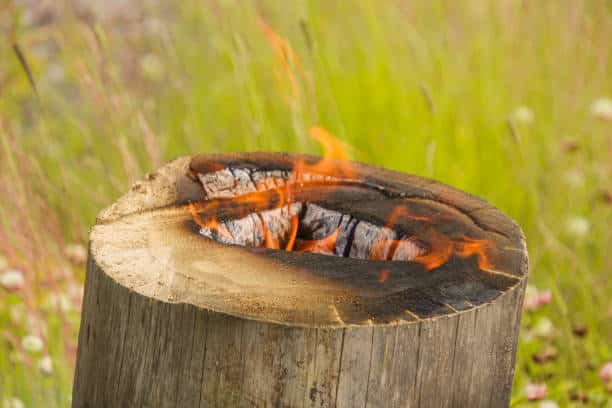So, you’ve successfully removed that bothersome tree from your yard, but now you’re left with an unsightly stump. While hiring a professional for stump removal is always an option, burning the stump is viable and it doesn’t cost a lot to remove the tree stump. If done correctly, this method is not just efficient but also straightforward. This comprehensive guide aims to provide you with a step-by-step roadmap on how to burn a tree stump safely and effectively.
Table Of Contents
−- What You’ll Need to Get Started
- Prioritize Safety: What You Must Know
- Pre-Burn Checklist: Weather and Timing
- Preparing the Stump for Burning
- Making the Stump Flammable
- Lighting Up the Stump: What to Expect
- Post-Burning Responsibilities: Don’t Forget the Embers
- Other Methods: The Charcoal Option
- The Pros and Cons of Burning a Tree Stump
- Is Burning the End-All Solution?
- Conclusion
What You’ll Need to Get Started
Before you strike the first match, make sure you’ve gathered all the necessary materials. These include:

- A one-inch spade bit for drilling holes
- An eight to ten-inch bit extender
- Potassium nitrate or saltpeter funneled into a container
- A plastic scoop or garden spade
- A bucket of boiling water, or a spout-equipped cup
- Leftover wood pieces for kindling
- Matches or a fire starter
- A sturdy shovel
Prioritize Safety: What You Must Know
Safety is paramount when attempting to burn a tree stump. Always check with your local fire department to confirm that you are allowed to light open fires, especially during drought conditions.
Equally important is the safe handling and storage of potassium nitrate, which is volatile if misused. Also, ensure that a reliable water source is easily accessible—this can be barrels of stored water or a hose connected to a tap.
Pre-Burn Checklist: Weather and Timing
Before you set anything ablaze, verify the weather conditions. The last thing you want is to attempt this on a windy or blustery day that could cause the fire to spread uncontrollably. Mark your calendar to avoid such days and aim for optimal conditions instead.
Preparing the Stump for Burning
To achieve the best results, the stump should ideally be dry or seasoned for at least 12-18 months. Use a chainsaw to cut it as close to the ground as possible. Then clear a radius of at least three feet around the stump, removing any flammable materials like leaves or debris. A containment circle made of pebbles or bricks can also add an extra layer of safety.
Making the Stump Flammable
Start by drilling holes across the top, sides, and into the roots of the stump using your one-inch spade bit and extender. Once drilled, use a funnel to fill each hole with potassium nitrate. Following this, pour hot water into these holes to help dissolve the chemical, making the stump more susceptible to burning. Allow several weeks for the stump to absorb these chemicals before moving on to the next step: the actual burning.
Lighting Up the Stump: What to Expect
Place kindling or scrap wood on or around the stump, ensuring proper airflow. Light it and let the stump catch fire, adding more wood as needed. Depending on various factors like the stump’s size, age, and the effectiveness of the potassium nitrate, the burn could last anywhere from several hours to an entire day.
Post-Burning Responsibilities: Don’t Forget the Embers
Once the stump has turned to bright embers, your job isn’t done. Keep an eye on the residual heat, as these embers can stay hot for days. Once you’re confident that the fire is completely out, fill the resulting hole with soil, and reseed the area if necessary.
Other Methods: The Charcoal Option
Another way to remove a stump is through the use of charcoal and firewood. Similar preparation steps apply here as well. You could also consider using a steel drum to intensify the heat, which assists in burning the stump more efficiently.
The Pros and Cons of Burning a Tree Stump
Pros:
- Efficient and relatively quick compared to other methods.
- Minimal physical effort is required.
Cons:
- Safety concerns including fire spreading.
- Potential damage to nearby areas like lawns.
- Environmental impact due to smoke and emissions.
Is Burning the End-All Solution?
Yes, burning a tree stump is an effective method to ensure the stump and its roots don’t sprout new shoots, thereby killing it entirely.
Conclusion
While burning a tree stump is a relatively simple process, it demands a thorough preparation phase and vigilant monitoring. Remember to exercise utmost caution, consult local regulations, and be prepared for any exigencies. With careful planning and safety measures, burning can be a very practical method for tree stump removal.

Editorial Staff
Our writers, editors, content managers, and SEO specialist. We all take part in crafting amazing articles. We spend hours ensuring that each article is based on facts, researched, and thorough. You'll never want to click the back button to look for more answers other than here!
